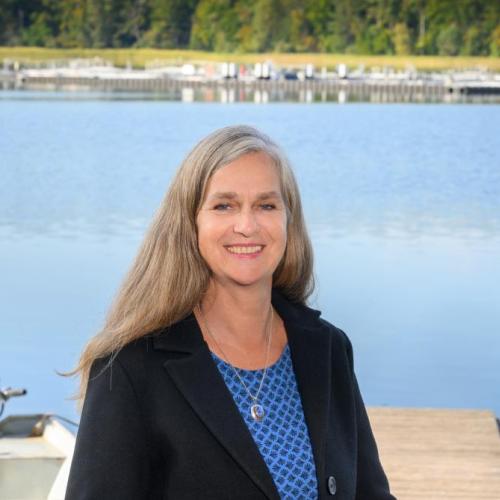
With the help of two mobile phone apps, Igor Ogashawara and Lena Mellin want to assess the water quality of lakes considering their water colour. In an interview, they explain how these apps work and why remote sensing is so useful for their research. | Photo: Martina Bauchrowitz
You are both involved in the CONNECT project, Igor Ogashawara as postdoctoral researcher and Lena Mellin as part of her bachelor's thesis. How did you get to IGB Stechlin?
Igor Ogashawara: For me it was an unbelievable coincidence. At the end of my doctoral thesis at the Indiana University – Purdue University at Indianapolis (IUPUI), I published a book on remote sensing of inland waters with two colleagues. One morning, when I wanted to look up something on Google and entered the title of our book "Bio-optical Modeling and Remote Sensing of Inland Waters" as keywords, a job posting with an almost identical title suddenly popped up. It seemed to be made for me, but the application deadline ended exactly on that day. So, I sent my documents immediately and after the interviews the job was offered to me.
Lena Mellin: My way to Lake Stechlin was not so far. I grew up just an hour from here in a small village between Neuruppin and Rheinsberg. Some time ago, my father, who works in our district administration in hunting, fishing and water protection, took me to an open day at IGB Stechlin. I found the presented projects very interesting and therefore asked if it would be possible to participate. And it worked out, now I am doing my bachelor thesis under Igor’s supervision.
What is your bachelor thesis about?
Lena Mellin: I'm testing two apps that were developed to estimate the water colour, a proxy providing insights into water quality. The thesis will evaluate if it is possible to generate reliable information with these apps, especially because they could be used by anyone who is on or around a lake, e.g. fishermen, recreational anglers, boaters or walkers. In this way, citizen scientists could easily provide data about a lake with their mobile phones.
Igor Ogashawara: To be aware of the water quality is particularly important for lakes that are employed in drinking water supply. For this purpose, more and more remote sensing techniques from satellites or aircraft are being used to monitor these aquatic systems. However, satellites cannot measure when it is cloudy, and working with airplanes is often too expensive. Other techniques are therefore needed. And one of them is to attract citizen scientists and give them these mobile phone apps.
What is the basis of the two apps?
Igor Ogashawara: These apps determine the colour of the water based on photos. Pure water is colorless. Only the constituents – e.g. minerals, suspended particles, organic matter and algae floating within the water column – are responsible for the colour of the water. For example, calcareous lakes often appear turquoise due to the calcite crystals and nutrient-rich lakes look green because algae can easily grow. The colour of the water can therefore be used to specify the constituents of a lake and its water quality.
How do the two apps work?
Lena Mellin: It's relatively simple. You take photos of the water surface and try to estimate the water colour. The first app – developed by Dutch scientists and called "Eye On Water" – compares the water colour on the photo with a colour scale displayed by the app. The second app developed in the USA, called "HydroColor", works similarly. However, for a better colour balance, HydroColor requires not only a photo of the water surface but also pictures of the sky and of a grey card with equal black and white portions.
Igor Ogashawara: The goal is to provide good data. Therefore, it is important to follow some rules which are explained by the apps. For example, shadows and glare effects must be avoided. And depending on the app, the smartphone has to be moved to a certain position to take the photos.
How do you find out if the apps really provide reliable data?
Lena Mellin: To do this, we compare the results that we obtain with the apps with values that we record in parallel with sensors. On the one hand we work with handheld devices that are hold directly above the water surface to determine the water colour. On the other hand, we also rely on data measured by sensors in airplanes or satellites.
But you also go a step further and try to deduce the amount of algae from the water colour.
Igor Ogashawara: Yes, that is one aspect that I am particularly interested in. Based on our data on water colour, I model how large the amount of algae and cyanobacteria is in the water. Chlorophyll and phycocyanin concentrations help me to do this. These are the photosynthetically active pigments of these organisms. Cyanobacteria, also known as blue-green algae, are particularly important in this respect. Because there are toxin-producing species among them, it can be dangerous to swim in lakes with blue-green algae blooms or to use the water as drinking water.
In the CONNECT project, you are also investigating to which extent algal blooms are transported from lake to lake when the systems are connected.
Igor Ogashawara: Correct. Using weather forecasts, researchers are already trying to predict whether and where algal blooms will spread depending on the wind direction. This is of particular interest for connected water systems such as the Havel Lakes or the 5 Great Lakes of North America. This is why the US National Oceanic and Atmospheric Administration (NOAA) is publishing bulletins on the algal situation in Lake Erie between July and October.







